Shopping Cart
- Remove All

Your shopping cart is currently empty


| Pack Size | Price | Availability | Quantity |
|---|---|---|---|
| 1 mg | $53 | In Stock | |
| 2 mg | $75 | In Stock | |
| 5 mg | $126 | In Stock | |
| 10 mg | $197 | In Stock | |
| 25 mg | $328 | In Stock | |
| 50 mg | $489 | In Stock | |
| 100 mg | $713 | In Stock | |
| 1 mL x 10 mM (in DMSO) | $148 | In Stock |
| Description | BAY 61-3606 dihydrochloride (BAY 61-3606) is a potent and selective inhibitor of Syk kinase (Ki = 7.5 nM). |
| In vitro | BAY 61-3606 is a highly selective inhibitor of Syk kinase. Other selected tyrosine kinases, Lyn, Fyn, Src, Itk, and Btk, are not inhibited by BAY 61-3606 in concentrations up to 4.7 μM. BAY 61-3606 is also found to inhibit B cell receptor (BCR)-mediated signaling[1]. Bay 61-3606 is a sensitizer of TRAIL-induced apoptosis. Mcl-1 downregulation by Bay 61-3606 are concentration- and time-dependent in MCF-7 cells. phosphorylation of Syk is reduced by Bay 61-3606 in MCF-7 and T47D cells. Downregulation of Mcl-1 by Bay 61-3606 is independent of Syk in breast cancer cells. Bay 61-3606 promotes the ubiquitin/proteasome-dependent degradation of the Mcl-1 protein in MCF-7 cells. Bay 61-3606 inhibits the phosphorylation of CDK9, RNA polymerase II, and Mcl-1 expression in MCF-7 cells. Bay 61-3606 inhibits CDK9 kinase activity with an in vitro IC50 of 37 nM[2]. |
| In vivo | After 20 days of drug administration, the volume of the xenografted tumor was significantly (P <0.001) reduced the efficacy of Bay 61–3606 when administered in TRAIL combination[2]. Oral administration of BAY 61-3606 to rats significantly suppresses antigen-induced passive cutaneous anaphylactic reaction, bronchoconstriction, and bronchial edema at 3 mg/kg. Furthermore, BAY 61-3606 attenuates antigen-induced airway inflammation in rats[1]. |
| Kinase Assay | GST-Syk (3.2?ng), 0.5?μg AL, 30?μM ATP, and testing compound in the presence of 0.25% Me2SO are mixed in 50?μL/well of kinase assay buffer in polypropylene U-bottom 96-well microtiter plates. The mixture is incubated for 1?h at room temperature, and the reaction is terminated by the addition of 120?μL of termination buffer. To capture AL, 120?μL of the terminated mixture is transferred to streptavidin-coated plates, followed by incubation at room temperature for more than 30?min. After three ishes with washing buffer, 100?μL of antibody buffer is added and incubated at room temperature for more than 30?min. After three more ishes, 100?μL of enhancement solution is added. Time-resolved fluorescence is measured by multilabel counter ARVO. |
| Cell Research | MCF-7 cells are exposed to TRAIL (indicated concentrations:0, 12.5, 25, 37.5 ng/ml) with or without Bay 61-3606 (2.5 μM) for 24 h; After exposure to the agents for 12 h, MCF-7 cells are subjected to immunocytochemistry using an active Bak antibody; Caspase activity is measured in MCF-7 cells exposed to Bay 61-3606 (5 μM) with or without TRAIL (50 ng/ml) for 24 h.(Only for Reference) |
| Alias | BAY 61-3606, BAY-61-3606 dihydrochloride |
| Molecular Weight | 463.32 |
| Formula | C20H18N6O3·2HCl |
| Cas No. | 648903-57-5 |
| Storage | Powder: -20°C for 3 years | In solvent: -80°C for 1 year | |||||||||||||||
| Solubility Information | Ethanol: < 1 mg/mL (insoluble or slightly soluble) H2O: < 1 mg/mL (insoluble or slightly soluble) DMSO: 12 mg/mL (25.9 mM) | |||||||||||||||
Solution Preparation Table | ||||||||||||||||
DMSO
| ||||||||||||||||

Copyright © 2015-2024 TargetMol Chemicals Inc. All Rights Reserved.